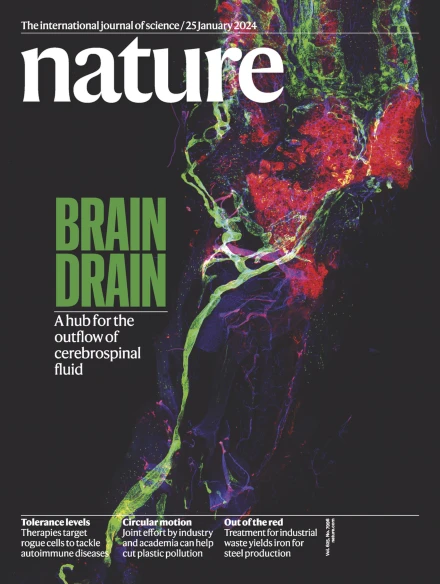Sleep pressure accumulates in a voltage-gated lipid peroxidation memory
IF 48.5
1区 综合性期刊
Q1 MULTIDISCIPLINARY SCIENCES
引用次数: 0
Abstract
Voltage-gated potassium (KV) channels contain cytoplasmically exposed β-subunits1–5 whose aldo-keto reductase activity6–8 is required for the homeostatic regulation of sleep9. Here we show that Hyperkinetic, the β-subunit of the KV1 channel Shaker in Drosophila7, forms a dynamic lipid peroxidation memory. Information is stored in the oxidation state of Hyperkinetic’s nicotinamide adenine dinucleotide phosphate (NADPH) cofactor, which changes when lipid-derived carbonyls10–13, such as 4-oxo-2-nonenal or an endogenous analogue generated by illuminating a membrane-bound photosensitizer9,14, abstract an electron pair. NADP+ remains locked in the active site of KVβ until membrane depolarization permits its release and replacement with NADPH. Sleep-inducing neurons15–17 use this voltage-gated oxidoreductase cycle to encode their recent lipid peroxidation history in the collective binary states of their KVβ subunits; this biochemical memory influences—and is erased by—spike discharges driving sleep. The presence of a lipid peroxidation sensor at the core of homeostatic sleep control16,17 suggests that sleep protects neuronal membranes against oxidative damage. Indeed, brain phospholipids are depleted of vulnerable polyunsaturated fatty acyl chains after enforced waking, and slowing the removal of their carbonylic breakdown products increases the demand for sleep. Sleep-inducing neurons in Drosophila rely on Hyperkinetic, the β-subunit of the KV1 channel Shaker, to monitor sleep need by translating lipid peroxidation events into changes in the oxidation state of a stably bound NADPH cofactor.


睡眠压力积聚在电压门控脂质过氧化记忆中
电压门控钾(KV)通道含有胞质暴露的β-亚单位1,2,3,4,5,其醛酮还原酶活性6,7,8是睡眠稳态调节所必需的。本研究表明,果蝇KV1通道激振器的β亚基Hyperkinetic形成了一种动态脂质过氧化记忆。信息存储在Hyperkinetic的烟酰胺腺嘌呤二核苷酸磷酸(NADPH)辅助因子的氧化状态中,当脂质衍生的羰基(如4-氧-2-壬烯醛或通过照亮膜结合光敏剂产生的内源性类似物)9,14提取电子对时,该状态发生变化。NADP+一直锁定在KVβ的活性位点,直到膜去极化允许其释放并被NADPH取代。睡眠诱导神经元15,16,17使用这种电压门控氧化还原酶循环编码其KVβ亚基集体二元状态下的近期脂质过氧化史;这种生化记忆影响并被驱动睡眠的脉冲放电抹去。脂质过氧化传感器存在于稳态睡眠控制的核心16,17,这表明睡眠可以保护神经元膜免受氧化损伤。事实上,在强制清醒后,大脑磷脂中脆弱的多不饱和脂肪酸酰基链被耗尽,并且减缓其羰基分解产物的去除会增加对睡眠的需求。
本文章由计算机程序翻译,如有差异,请以英文原文为准。
求助全文
约1分钟内获得全文
求助全文
来源期刊

Nature
综合性期刊-综合性期刊
CiteScore
90.00
自引率
1.20%
发文量
3652
审稿时长
3 months
期刊介绍:
Nature is a prestigious international journal that publishes peer-reviewed research in various scientific and technological fields. The selection of articles is based on criteria such as originality, importance, interdisciplinary relevance, timeliness, accessibility, elegance, and surprising conclusions. In addition to showcasing significant scientific advances, Nature delivers rapid, authoritative, insightful news, and interpretation of current and upcoming trends impacting science, scientists, and the broader public. The journal serves a dual purpose: firstly, to promptly share noteworthy scientific advances and foster discussions among scientists, and secondly, to ensure the swift dissemination of scientific results globally, emphasizing their significance for knowledge, culture, and daily life.
 求助内容:
求助内容: 应助结果提醒方式:
应助结果提醒方式:


